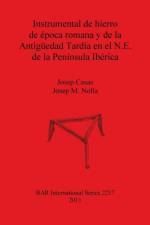- Vigilancia y control del territorio de Ampurias, Hispania Citerior, desde el siglo II a.C. al siglo III d.C. Estructura, secuencias e interpretacion
av Victoria Soler, Josep Casas & Josep M Nolla
1 491
The present volume on the site of Mas Gusó presents in detail the results obtained during fourteen excavation campaigns, focusing, this time, on the Roman settlement. This complex was built in the late second century BC over an old Iberian settlement, which in turn occupied the space on which an Early Iron Age community had previously settled, following a previous Bronze Age settlement. The Roman complex of Mas Gusó had a military-public function, as a praesidium intended to control the hinterland territories of Emporion and to take part in military actions within the province of Hispania Citerior, beginning with the Late Republic, c. 135 BC, and continuing for several centuries until its disappearance around 280 AD. During the first decades of the Common Era, the complex was probably transformed into a statio, directly linked to the local road network, although it did not lose its military function. The building presents a classical structure, showing a clear Italic influence that is observed repeatedly and with little variation throughout the Empire.En el presente volumen sobre Mas Gusó se exponen extensamente los resultados obtenidos a lo largo de catorce campañas de excavaciones, referidos, en esta ocasión, al establecimiento de época romana. Un complejo levantado hacia finales del siglo II a.C. sobre un antiguo asentamiento ibérico, el cual, a su vez, ocupó el mismo espacio en el que anteriormente se estableció una comunidad de la primera Edad del Hierro, sucesora de otra de la Edad del Bronce. El conjunto romano de Mas Gusó tuvo un carácter público-militar, un praesidium relacionado con el control del hinterland ampuritano y con las operaciones militares en la Hispania Citerior, desde la Baja República, hacia el 135 a.C., prolongándose su existencia a lo largo de los siglos, hasta desaparecer alrededor del año 280. A partir de las primeras décadas de nuestra era, probablemente fue transformado en una statio, vinculada directamente a la red viaria local, sin perder su función militar. Adopta una estructura clásica, de clara filiación itálica, que se repite con pocas variaciones a lo largo de todo el Imperio.



